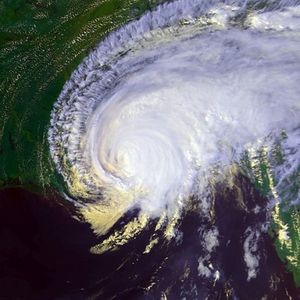Coastal land loss and wave-surge predictions during hurricanes in coastal Louisiana: implications for the oil and gas industry
Editor's Note: This article is excerpted directly from the Final Project Report prepared for the Louisiana Department of Natural Resources, U.S. Geological Survey, and U.S. Minerals Management Service published February 14, 2003. It has been edited only to conform to the Encyclopedia's style guidelines. Click here for part one and part two of the full report.
Executive Summary
The potential negative impact of hurricane-generated storm surge and wave energy on the oil and gas infrastructure located in coastal Louisiana is enormous. This can be attributed to: (1) the extent and number of facilities located there; and (2) the fact that barrier islands and marshes have drastically diminished during recent history and are predicted to continue doing so in the absence of implementing well designed, large-scale restoration plans. It is the primary objective of this pilot study to evaluate, using state-of-the-art numerical hydrodynamics models, how the loss of barrier islands and wetlands affects storm surge and wave energy along a portion of the south-central Louisiana coast.
Using a Hurricane Planetary Boundary model, a storm surge model (ADCIRC) and wave model (SWAN), the resultant data indicate that the vast majority of the study site underwent a considerable increase in combined surge and wave height during the interval 1950-1990’s on simulating a category 3 hurricane. This is an important period in time in that it represents the actual physical breakdown of the coast and to which the increase in surge and wave height can be directly attributed. Thus, the conclusion is important in that the data provide a highly unique data set demonstrating that the deterioration of coastal south-central Louisiana has likely resulted in an increase in surge and wave height during this 40-year time period. The magnitude of increase is typically 8-10 ft although change >12 ft is readily apparent along the marsh shorelines and barriers.
Over the approximate 30 year period between 1990’s and 2020, the model forecast results also indicate that a significant increase in surge and wave height will occur throughout much of the study site. Increases are widespread in the study area with the largest occurring at Fourchon, Timbalier islands and in particular, Isles Dernieres and the adjacent marshes. At these locations increasing values range from 10 to >12 ft. Throughout the marsh north of Terrebonne Bay, values increase from 6 ft, although in several location increases between 10 and >12 ft were computed.
The data presented here have very important implications for the oil and gas infrastructure located in the study site. The data suggest that in the absence of large-scale barrier and marsh restoration, the current infrastructure will experience increasing surge levels and increasing wave energy if the anticipated coastal erosion is permitted to occur. The data dramatically illustrate that nearly the entire infrastructure is potentially exposed to increased surge and wave heights over time. It also important to note that this conclusion pertains to tropical storms and weaker hurricanes that historically, are known to have a high frequency of landfall along the Louisiana coast.
